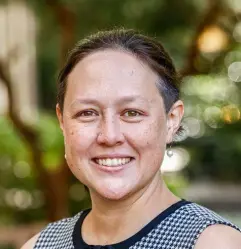When it comes to commercial real estate ownership in majority-Black neighborhoods, Black business owners are often systemically excluded from the economic benefits such ownership can generate, while other investors amass control over profits and the trajectory of neighborhood development.
“There is an assumption that [small business owners] can pay rent in South LA but cannot own property here,” Olympia Auset, a South Los Angeles-based small business owner, told us. “There are so many people here who stay in a rental property for 10 years or longer, but whenever they want to own something, they are given a hard time.” Auset’s words speak to a broader systemic trend not only in the historically Black area of South Los Angeles, but in majority-Black neighborhoods nationwide.
While much attention has been paid to the importance of homeownership in supporting economic mobility for Black people, commercial property ownership has been an understudied avenue for accomplishing this imperative. That’s changing: Last year, The Los Angeles Times covered the same uphill battle Auset referred to by chronicling the challenges that Black business owners face in purchasing commercial property in Leimert Park, a gentrifying neighborhood in South Los Angeles that has historically been a mecca for Black arts, culture, events, and businesses.
This report examines why racial disparities in commercial real estate ownership matter and offers recommendations for policymakers to better support Black entrepreneurs in their attempts to “buy back the block.” Drawing from a qualitative study conducted by Los Angeles-based organizations Inclusive Action for the City and Destination Crenshaw with Black business owners and real estate developers in South Los Angeles, the report presents the barriers they face in purchasing and managing commercial real estate. Based on qualitative insights and the existing evidence base on local ownership, the report offers five actionable recommendations for how policymakers can better support local efforts to purchase commercial real estate.
Why racial disparities in commercial real estate ownership matter
Much has been written about racial disparities in residential real estate, but until recently, almost no research has focused on commercial real estate and race. Brookings’s recent study “The devaluation of assets in Black neighborhoods: The case of commercial property” helps fill this gap. It finds that just like the housing market, commercial real estate is plagued by racial disparities, with Black and white households having disproportionate rates of commercial property ownership (3% and 8%, respectively). Moreover, for those households that do own commercial property, the average white household owns $34,000 worth, compared to just $3,600 for the average Black household.
These racial disparities in commercial property ownership have major ramifications for Black businesses and neighborhoods, including two pressing implications:
Racial disparities in commercial real estate restrict Black business owners’ capacity to grow their enterprises—and thus their wealth.
Black entrepreneurship is an important tool for closing the racial wealth gap, as it supports direct wealth creation, expands Black employment, and keeps local money circulating locally. Unfortunately, Black businesses have a higher failure rate than other businesses due to systemic barriers such as disparities in capital access and personal wealth, systemic devaluation, a high concentration of businesses in vulnerable industries, and in some “hotter” markets, disproportionally high rents that make it difficult for small businesses to afford their leases.
Racial disparities in commercial property ownership are not the sole source of higher failure rates for Black businesses by any means, but owning commercial property (rather than leasing) can help correct for them and be an important tool in supporting Black businesses. The business owners we interviewed expressed frustration about landlords’ unpredictable decisions to sell their buildings, which can displace local businesses and contribute to higher rates of business failure. As one small business owner told us, “I’ve been at my business for 22 years. The owners sold the property and now the new owners are giving us a year to move. We have to uproot our business. Ownership is the way to go so you have stability in your business.”
In fact, joint guidance from the Treasury Department, Federal Reserve, and the Federal Deposit Insurance Corporation formally recognizes owner-occupied commercial real estate as lower-risk for lenders. Local ownership of commercial real estate has been found to help stabilize rents and support vulnerable businesses in withstanding economic shock. Additionally, an Urban Institute study found a positive correlation between small businesses which received loans to purchase real estate and increased sales and job creation.
Racial disparities in both residential and commercial real estate limit Black Americans’ control over the trajectory of neighborhood development.
Predatory outside investors have historically targeted Black neighborhoods, which only worsened in the wake of the Great Recession as private equity groups, hedge funds, and institutional investors began to expand their property portfolios and purchase single-family homes and commercial properties in low-income and majority-minority neighborhoods.
Such land grabs have fueled growing interest in community ownership of residential assets (such as through community land trusts), but local ownership of commercial real estate can also be a powerful tool to ensure local control of neighborhood development. In hot markets, for instance, local ownership of commercial real estate can ensure affordability for entrepreneurs and help retain local businesses at risk of displacement. In cooler markets, it can increase residents’ access to much-needed amenities such as grocery stores and retail establishments. And in all markets, it can help residents shape the force of development in their neighborhoods.
The benefits of local ownership of commercial real estate are clear. But if owning commercial property was easy, most people would probably do it. Instead, efforts to expand local ownership run up against a host of systemic challenges related to limited capital absorption capacity. Just last year, South Los Angeles residents’ highly organized and well-financed effort to purchase their neighborhood’s 41-acre Baldwin Hills-Crenshaw Plaza Mall was lost to large institutional investors, who plan to transition the property into luxury housing and retail. As we wrote at the time, this was a missed opportunity to harness a powerful tool to preserve Black economic power and prevent displacement.
Why do Black small business owners, residents, and developers face such high barriers to ownership? And what can local governments do to facilitate more inclusive ownership and prosperity? To answer these questions, the next section of this report draws from on-the-ground perspectives from business owners, residents, and other key community stakeholders in South Los Angeles.
Five recommendations from the field on how city leaders can support efforts to ‘buy back the block’
“Why are we as a culture so unaware of property ownership?” asked Dyane Pascall, a South Los Angesles-based real estate investor and community advocate, in one of our interviews. “There is a history there. There was redlining, exclusion to lenders, and the GI Bill. We were systematically pushed out of pathways to ownership.”
Pascall’s words speak to Black and other people of color’s exclusion from real estate ownership in America, which extends beyond the 20th century back to slavery and colonialism. On-the-ground research from South Los Angeles provides insight into the systemic challenges Black small business owners, community groups, and developers face in acquiring commercial property. It also points to several recommendations for local governments to strengthen enabling environments and better support local entrepreneurs’ efforts to “buy back the block.” Five key recommendations are outlined below.
1. Create dedicated city funds for commercial real estate acquisition.
Many Black and brown Americans lack access to the capital needed to qualify for commercial loans, have higher rates of loan denials, receive smaller loans, and are charged higher interest rates than white people. Indeed, interviews with and surveys of South Los Angeles-based business owners revealed that access to capital—particularly for large down payments needed to close a deal—was their biggest barrier in purchasing commercial property.
“Down payments are always a challenge,” one business owner told us. “Even if a business owner can get a good deal on a property, loans do not 100% cover the cost of the property, and so the additional expenses not covered by the loan tend to be a challenge.”
Moreover, government programs tend to move slow, and small business owners can easily lose the opportunity for acquisition while assembling a capital stack from sources that are not built to move quickly. As one Los Angeles city official told us, “The city is not in the business of doing business, so we should figure out how to get the money to people who can. It’s really important to make sure that the funding doesn’t come with so many strings attached that people get bogged down in reporting and monitoring instead of doing what they set out to do.”
To correct for these challenges, local leaders could establish dedicated loan funds to help supply the large upfront capital (e.g., down payment assistance, closing costs, proof of operating cost) needed to supplement conventional commercial real estate loans and/or Small Business Administration loans. These loans should be borrower-friendly, with either zero or below-market interest and lenient repayment terms, and administered quickly to meet the pace of commercial real estate deals.
As a promising local example, in 2022, Washington, D.C. launched a Commercial Property Acquisition Fund that provides down payment assistance of up to a quarter of the sales price to disadvantaged small business owners to remain in the District.i This fund is part of the mayor’s $40 million legacy initiative to support “Black residents and businesses to remain or return to thriving in the District of Columbia.” Similarly, in 2021, Seattle announced a Strategic Investment Fund that allocates $30 million “for land and property acquisition to respond to disproportionate displacement pressures impacting Black, Indigenous and people of color communities.”
2. Invest in community-based organizations to provide technical assistance for commercial real estate ownership.
Even if down payment assistance and quick capital were easily available to small business owners, the processes for successfully locating, financing, and closing on a commercial real estate property deal are opaque, complicated, and difficult to navigate. Technical assistance could help, but not all residents and businesses know where to look or how to best to access it.
“We get a lot of discouraged borrowers who have applied to grants and think the system is rigged,” said a South Los Angeles-based stakeholder at a community development financial institution (CDFI). “We try to let them know it takes two to three or four to five times, don’t give up. It’s important to be able to understand where they’re coming from, to look like the community, be able to speak their language, and be able to relate to their issues on a personal level. They may not be able to speak a banker’s language, but they’re used to operating within the community.”
To meet the growing need for technical assistance on the acquisition and purchasing process for commercial real estate, local governments should fund community-based technical assistance providers to train “hard-to-reach” communities. A promising example is Buffalo, N.Y.’s East Side Avenues initiative, which—among other investments—is training East Side residents in commercial real estate development through a Community-Based Real Estate Development Training program (CBREDT). CBREDT is a tuition-free, non-credit-bearing, 23-week adult education program that provides students with an overview of commercial real estate development (including predevelopment, construction, and project financing), offers weekly lectures and hands-on activities by local professionals, connects students with mentors, and guides students toward a final project presented to a panel of jurors. Another example is Seattle’s Office of Arts and Culture’s Build ArtSpace Equitably (BASE) certification program, which launched in 2018 with the goal “to build capacity in communities of color to build permanent affordable cultural spaces and to extend the ‘onramp’ to commercial real estate development further into cultural communities.”
3. Start a commercial community land trust pilot program.
Many South Los Angeles-based interviewees expressed interest in pursuing commercial real estate acquisition through collective community ownership models such as cooperatives and land trusts. Despite growing interest, however, neither conventional financial institutions nor federal government financial products are designed to finance these ownership types. As one interviewee told us, “Currently, there are not any wide-scale public resources available for a lot of these community real estate models.” As a result, community-serving nonprofits must raise funds to purchase a property through donations or conventional loan products, which are difficult to obtain.
A robust body of evidence demonstrates that in strong market neighborhoods, community ownership models can be useful tools to empower tenants, ensure affordability for entrepreneurs, and retain local businesses and organizations who may otherwise be displaced. In weak markets, they can provide a foundation for vitality and enterprise where the conventional market has failed.
To facilitate these community benefits, local governments can create commercial community land trust pilot programs. For example, in July 2022, the Los Angeles County Board of Supervisors approved a commercial community land trust pilot program that provides financing to mission-driven organizations seeking to establish commercial community land trusts. These organizations are then required to enter into community benefit agreements with provisions such as affordable commercial rent.
4. Apply land banking to the commercial property context.
For decades, local governments have tackled issues of absentee or bank ownership, title issues, tax delinquency, and other barriers to productive use and local ownership with land banks to facilitate residential ownership. This same idea can work for commercial property.
One example is Prince George’s County, Md.’s Redevelopment Authority (RDA), which focuses on decreasing the number of vacant commercial and residential structures within a half-mile radius of transit centers to enhance quality of life and promote mixed-use, transit-oriented development. In 2013, the RDA acquired three adjacent commercial buildings comprising an entire block in the heart of downtown Mount Rainier—each left vacant for decades by absentee landowners—and sold the parcels to a local Black developer who renovated the structures into new commercial storefronts at the street level and rental apartments above. This kind of parcel assembly requires technical expertise and significant patient capital—the two ingredients for a successful land bank that a typical local private developer can’t provide.
5. Utilize economic development tax credits to help small businesses buy property.
Every year, local, state, and federal governments collectively spend between $45 billion and $90 billion on economic development tax credit initiatives—providing direct financial benefits (including property tax abatements, job creation tax credits, tax increment financing, and capital grants) to firms to encourage their opening, expansion, or retention in an area. But a major criticism of these tax credits and subsidies is that they target the largest corporations without any guaranteed benefits to local residents.
Rather than focus on outside investment and business attraction, local governments should create tax credits to support real property ownership for existing small businesses, particularly small businesses owned by people of color. There are many examples of state and local governments creating tax incentives for small business incubation and stabilization, as well as tax credits for residential homeowners of almost all kinds. However, there is a largely untapped opportunity for governments to leverage tax credits to support small business property ownership, which the evidence base presented in this report suggests would grow these businesses and create new economic activity and jobs.
The time is now to ‘buy back the block’
Local ownership of commercial real estate is a critical tool for supporting Black entrepreneurs and small business owners in retaining, growing, and scaling their businesses. Moreover, by giving residents more control over the trajectory of neighborhood development, local ownership can be a powerful tool for civic engagement in Black communities. There is an important role to play for policymakers across all levels of government in facilitating local ownership of commercial real estate, and they should listen to their communities’ small business owners about what supports are most urgently needed.
Small businesses deserve to have a place in their community’s future without having to suffer the collateral damages caused by real estate market speculation, systemic barriers, and a global pandemic. Recommended programs and policies can further support local businesses and entrepreneurs’ opportunity to obtain part of the coveted American Dream, which has been historically denied to people of color.
The authors thank Robin Hacke and Jennifer S. Vey for their reviews of this piece.





